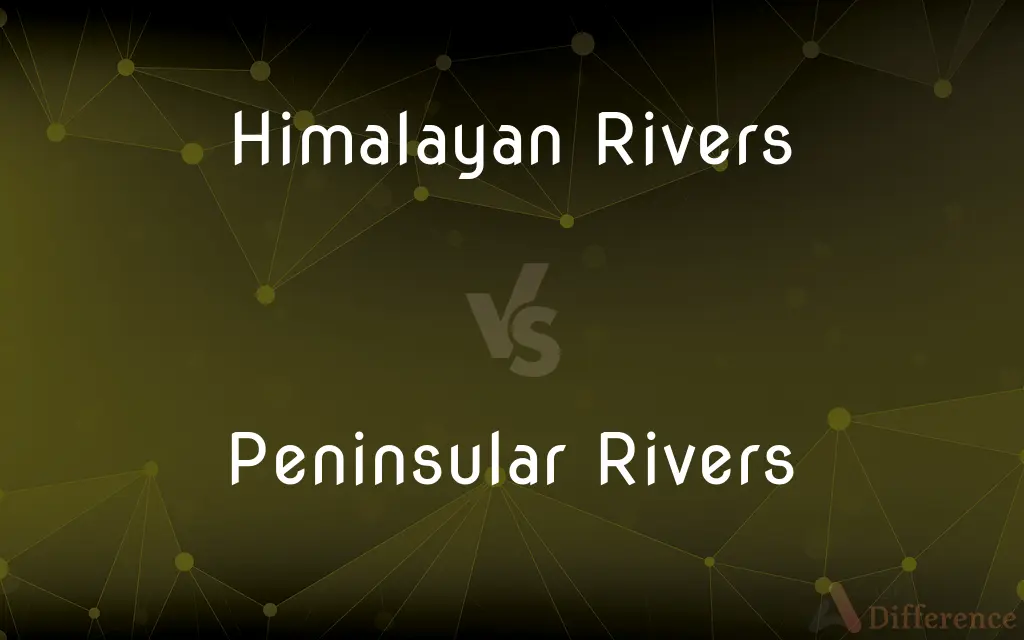Himalayan Rivers vs. Peninsular Rivers — What's the Difference?
By Tayyaba Rehman — Published on November 29, 2023
Himalayan Rivers originate from the Himalayan mountains and are perennial, while Peninsular Rivers arise from the Indian plateau and can be seasonal.

Difference Between Himalayan Rivers and Peninsular Rivers
Table of Contents
ADVERTISEMENT
Key Differences
Himalayan Rivers and Peninsular Rivers are two distinctive river systems in India that vary in origin, course, and characteristics. The Himalayan Rivers are born in the icy Himalayan ranges. These rivers, owing to their glacial origins, are perennial. It means that Himalayan Rivers flow consistently throughout the year, receiving water both from melting glaciers and monsoon rains.
Contrarily, the Peninsular Rivers have their sources in the western and eastern ghats of the Indian peninsular plateau. Unlike the Himalayan Rivers, many of the Peninsular Rivers are seasonal. These rivers largely depend on the monsoon rains. During the dry season, many Peninsular Rivers may see reduced flow or even dry up in certain stretches.
The courses that Himalayan Rivers and Peninsular Rivers traverse also differ significantly. Himalayan Rivers tend to have long, winding courses, often meandering through plains, creating fertile alluvial basins. The Indus, Ganges, and Brahmaputra are classic examples of Himalayan Rivers. In contrast, Peninsular Rivers have shorter and more direct courses, often leading to rapid drainage. Rivers like the Godavari, Krishna, and Cauvery belong to the Peninsular category.
In terms of utility, Himalayan Rivers play crucial roles in irrigation, navigation, and hydroelectric power due to their persistent flow. Meanwhile, Peninsular Rivers, although equally significant, might have limitations in year-round utility because of their seasonality.
Comparison Chart
Origin
Himalayan Mountains.
Indian Peninsular Plateau.
ADVERTISEMENT
Perennial vs. Seasonal
Perennial (flow all year round).
Mostly seasonal (depend on monsoon).
Course
Long, winding courses.
Shorter, more direct courses.
Major Rivers
Indus, Ganges, Brahmaputra.
Godavari, Krishna, Cauvery.
Dependency
Glacier melt and monsoon rains.
Mainly monsoon rains.
Compare with Definitions
Himalayan Rivers
Long rivers that create fertile alluvial basins.
The fertile plains alongside Himalayan Rivers have dense populations.
Peninsular Rivers
Water bodies that may dry up in certain stretches during the non-monsoon months.
Some stretches of the Peninsular Rivers become shallow or even dry during summer.
Himalayan Rivers
Perennial watercourses with Himalayan glacial sources.
Due to their perennial nature, Himalayan Rivers support extensive agriculture.
Peninsular Rivers
Rivers that play a crucial role in the regional agriculture of South India.
The Krishna River is vital for irrigating crops in both Andhra Pradesh and Karnataka.
Himalayan Rivers
Rivers contributing significantly to irrigation and power generation.
The Brahmaputra, a Himalayan River, plays a vital role in the region's hydroelectric projects.
Peninsular Rivers
Rivers with shorter and steeper courses than their Himalayan counterparts.
The Cauvery River, a Peninsular River, has a relatively direct route to the Bay of Bengal.
Himalayan Rivers
Rivers fed by both melting glaciers and monsoons.
Himalayan Rivers have consistent flows, thanks to their dual water sources.
Peninsular Rivers
Watercourses largely dependent on monsoon rainfall.
The flow of many Peninsular Rivers intensifies during the monsoon season.
Himalayan Rivers
River systems originating from the Himalayan range.
The Ganges is one of the major Himalayan Rivers, flowing across Northern India.
Peninsular Rivers
River systems emerging from the Indian peninsular plateau.
The Godavari, originating in the Western Ghats, is a prominent Peninsular River.
Common Curiosities
Are Himalayan Rivers perennial?
Yes, they flow throughout the year, sourced from glacial melts and monsoons.
What defines Peninsular Rivers?
These are rivers originating from the Indian peninsular plateau.
Which are the main Himalayan Rivers?
The major ones include the Indus, Ganges, and Brahmaputra.
What are Himalayan Rivers?
They are river systems that originate from the Himalayan mountain range.
Which rivers are classified as Peninsular Rivers?
Major Peninsular Rivers include the Godavari, Krishna, and Cauvery.
Do Peninsular Rivers flow year-round?
Many are seasonal, relying on monsoon rains and may have reduced flow or dry up outside the monsoon.
Are there any major deltas formed by these rivers?
Yes, both systems form deltas, like the Ganges-Brahmaputra Delta by Himalayan Rivers and the Godavari Delta by Peninsular Rivers.
Why are Himalayan Rivers vital for agriculture?
Their perennial nature ensures consistent irrigation.
Can Peninsular Rivers be used for navigation?
Yes, but their utility might be limited in certain stretches, especially outside the monsoon season.
How does climate change impact Himalayan Rivers?
Melting glaciers due to global warming can alter their flow patterns and volumes.
Which river system is longer, Himalayan or Peninsular?
Himalayan Rivers generally have longer courses.
Are there any environmental concerns related to these rivers?
Yes, issues like pollution, over-extraction, and damming affect both river systems.
Do both river systems contribute to hydroelectric projects?
Yes, but Himalayan Rivers play a more significant role due to their persistent flow.
Why is there a difference in the flow nature between the two river systems?
It's mainly due to their origins - glacial and high-altitude for Himalayan Rivers and plateau-based with rainfall dependence for Peninsular Rivers.
Are Peninsular Rivers crucial for South Indian agriculture?
Absolutely, they are essential for irrigation in many southern states.
Share Your Discovery

Previous Comparison
Full Moon vs. New Moon
Next Comparison
Conceding vs. YieldingAuthor Spotlight
Written by
Tayyaba RehmanTayyaba Rehman is a distinguished writer, currently serving as a primary contributor to askdifference.com. As a researcher in semantics and etymology, Tayyaba's passion for the complexity of languages and their distinctions has found a perfect home on the platform. Tayyaba delves into the intricacies of language, distinguishing between commonly confused words and phrases, thereby providing clarity for readers worldwide.
















































